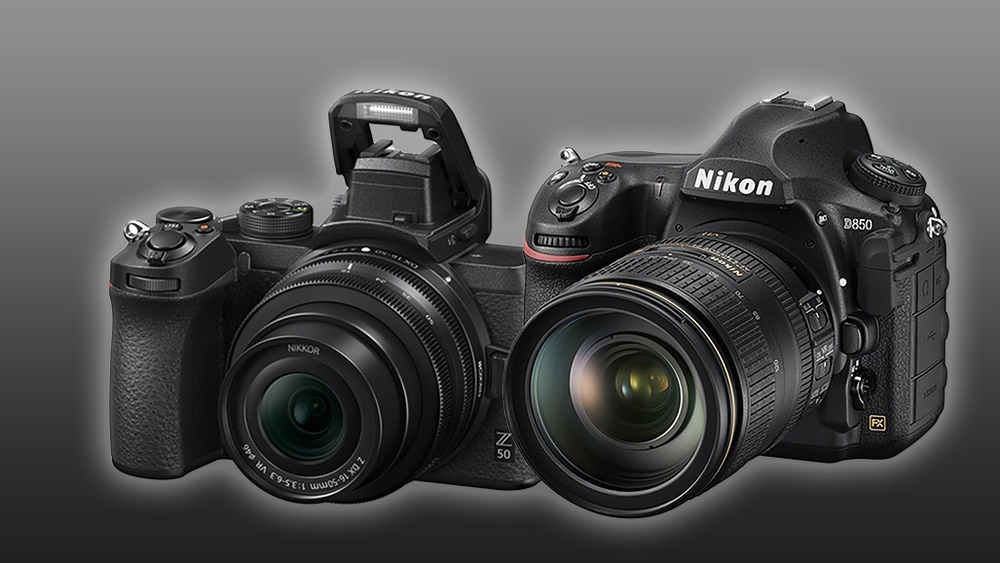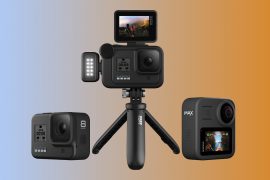Nikon is one of the leading camera producers that offer many different models, their camera lines are divided into two types: the classic DSLR “D” series, and the new mirrorless “Z” series. Right now, Nikon is pouring a ton of energy into its full-frame mirrorless lineup. However, they have such a long history of making DSLRs that the DSLR lineup is arguably more refined at this point.
This article explains the design of these two camera types, how they work, and finally, makes a full comparison to show their advantages. So, let us begin
Nikon DSLR camera- The “D” series
Nikon announces the D1, the world’s first practical DSLR on 15 June 1999. DSLR stands for Digital Single-Lens Reflex camera. It’s a type of digital camera that is widely used by professional and amateur photographers alike. Also, DSLRs are popular because they offer greater flexibility and control over the final image than point-and-shoot cameras.

DSLR cameras work by using a mirror to reflect light from the lens to the viewfinder, and then flipping the mirror up to expose the image sensor to light when the shutter button is pressed. The image sensor captures the image, which is processed by the camera’s image processor to create a digital image.
The image sensor is part of the camera that captures the image. It’s made up of millions of tiny light-sensitive cells called pixels. When light hits the pixels, they generate an electrical signal that is processed by the camera’s image processor to create a digital image.
The size and quality of the image sensor are the key factors that determine the quality of the final image. There are two sizes of sensors used in Nikon DSLRs cameras:
- DX-format sensor (cropped sensor): It has a smaller size of 24x16mm
- FX-format sensor (full frame sensor): It has a larger size, it measures 36x24mm which is approximately the same size as 35mm film.
Another important feature of DSLRs is the ability to change lenses. Different lenses are designed for different types of photography, such as wide-angle lenses for landscapes, telephoto lenses for sports and wildlife, and macro lenses for close-up photography.
DSLRs also offer a wide range of manual controls that allow the photographer to adjust settings such as shutter speed, aperture, and ISO sensitivity. These settings can be used to create a wide variety of creative effects and are essential for taking full control of the final image.
In summary, DSLR cameras work by using a mirror to reflect light from the lens to the viewfinder and then flipping the mirror up to expose the image sensor to light when the shutter button is pressed. The image sensor captures the image, which is processed by the camera’s image processor to create a digital image. DSLRs offer greater flexibility and control than point-and-shoot cameras, thanks to features such as interchangeable lenses and manual controls.
Examples of Nikon DSLR cameras-D series

Nikon D7500 – Entry-level DSLR
Nikon D850 – Semi-professional DSLR
Nikon D6 – Professional DSLR
Nikon Mirrorless Camera- The “Z” series
Nikon announces the Z Series Mirrorless cameras in 2018. Unlike DSLR cameras, which use a mirror to reflect light from the lens to the viewfinder, mirrorless cameras do not have a mirror. Instead, they use an electronic viewfinder (EVF) and/or a rear LCD screen to preview and capture images.

In a mirrorless camera, light from the lens is directed straight onto the image sensor. There is no mirror to reflect the light to a separate viewfinder. Instead, the image sensor sends a live view of the scene to an electronic viewfinder or the rear LCD screen. This live view is created by a small secondary sensor that constantly reads the image sensor and sends a feed to the electronic viewfinder or LCD screen.
Like DSLRs, mirrorless cameras use interchangeable lenses, but they can also use adapters to mount lenses from other systems. This means that photographers can use a wider range of lenses, including vintage lenses, and can take advantage of different manufacturers’ lens systems.
Finally, mirrorless cameras often offer more advanced video capabilities than DSLRs. Because the image sensor is constantly sending a live view to the electronic viewfinder or LCD screen, mirrorless cameras can often shoot high-quality video with autofocus and other advanced features.
In summary, mirrorless cameras work by directing light from the lens straight onto the image sensor, with no mirror to reflect the light to a viewfinder. This allows them to be smaller, lighter, and quieter than DSLR cameras, while still offering interchangeable lenses and advanced features. If you’re looking for a camera that offers a combination of high-quality stills and video with advanced features in a compact package, a mirrorless camera may be the right choice for you.
Examples of Nikon Mirrorless Camera- Z series

Nikon Z50– Entry-level Mirrorless camera
Nikon Z7 II – Semi-professional Mirrorless camera
Nikon Z9 – Professional Mirrorless camera
The Comparison
1. The advantages of Nikon’s D-series DSLR camera over the Z-series mirrorless camera

As technology evolves, the market for cameras is becoming more competitive, with DSLRs and mirrorless cameras fighting for supremacy. Both D series DSLR Nikon cameras and Z series mirrorless cameras have their pros and cons, but in this section, we will focus on the pros of D series DSLR Nikon cameras over Z series mirrorless cameras.
- Battery life: One of the most significant advantages of D series DSLR Nikon cameras is their battery life. These cameras are equipped with a mirror, which consumes less energy than the electronic viewfinder of mirrorless cameras. DSLR Nikon cameras can shoot for longer hours without needing a battery recharge, which is a significant advantage for professional photographers who need their cameras to last for an entire day of shooting.
- Ergonomics: DSLRs have a more traditional design that allows for a better grip and easy access to the camera controls. For many photographers, this design is more comfortable and feels more natural. Furthermore, DSLR cameras are generally larger than mirrorless cameras, which can be an advantage for photographers with bigger hands.
- Faster burst rates: DSLRs have a faster response time than mirrorless cameras, which is crucial when capturing fast-moving action or sports. DSLRs can take multiple shots per second, allowing photographers to capture a series of images quickly. The continuous shooting mode of DSLRs is faster and more reliable than that of mirrorless cameras, giving photographers more control and flexibility.
- A larger selection of lenses: Nikon’s DSLR system has been around for much longer than its mirrorless system, so there are more lenses available for DSLRs. Additionally, many third-party lens manufacturers make lenses for Nikon DSLRs, which gives photographers more options.
- Storage Slots: Nikon D cameras generally have dual memory card slots that can accommodate SD cards, XQD cards, or a combination of the two. While Nikon Z cameras typically have a single XQD or CFexpress slot for storage.
- More affordable: D series DSLR Nikon cameras are more affordable than Z series mirrorless cameras. DSLRs have been on the market for a long time, which has resulted in a wide range of models with varying prices. Moreover, lenses for DSLR cameras are generally cheaper than lenses for mirrorless cameras. This affordability factor makes DSLRs a better option for beginners or photographers on a tight budget.
2. Advantages of Nikon’s Z-series mirrorless camera over Nikon’s D-series DSLR camera

The camera industry has been evolving rapidly over the years, and the emergence of mirrorless cameras has brought significant changes to the game. Nikon, one of the leading camera manufacturers, has recently launched its new Z series mirrorless camera, which offers several advantages over its D series DSLR camera.
In this section, we will discuss the pros of the Z series Nikon mirrorless camera over the D series DSLR Nikon camera.
- Smaller size and weight: The first and most significant advantage of the Z series Nikon mirrorless camera is its smaller size and weight. Unlike the bulky D series DSLR camera, the Z series mirrorless camera is lightweight and easy to carry around. This smaller size and weight make it easier for photographers to carry the camera around for extended periods, without experiencing fatigue or discomfort.
- Viewfinder (EVF): Another advantage of the Z series Nikon mirrorless camera is its electronic viewfinder (EVF). The EVF is a digital display that provides a live preview of the image the camera will capture. This feature provides better image preview and more precise framing of shots.
The EVF also offers a more accurate representation of the final image, allowing photographers to adjust the camera settings to get the perfect shot. Furthermore, the EVF in the Z series mirrorless camera can display a variety of information, such as histograms, focus peaking, and exposure levels, which helps photographers in their image composition.
- Advanced autofocus system: The Z series Nikon mirrorless camera also offers a more advanced autofocus system. The Z series camera comes with Nikon’s Hybrid Autofocus system, which uses both phase detection and contrast detection autofocus. This system enables the camera to detect subjects more accurately and more quickly than the D series DSLR camera.
The autofocus system in the Z series camera also allows for eye-detection autofocus, making it easier for photographers to focus on their subject’s eyes.
- In-Body Image Stabilization: All Nikon Z cameras have in-body image stabilization, which allows for sharper images and smoother video, especially when using non-stabilized lenses. Most Nikon D cameras do not have in-body image stabilization, although a few newer models like the D780 and D850 have started to incorporate this feature.
- Better video capabilities: The Z series Nikon mirrorless camera offers better video capabilities than the D series DSLR camera. The Z series camera can record 4K video at 60 frames per second, providing better video quality than the D series DSLR camera. Furthermore, the Z series camera offers in-camera stabilization, which reduces camera shake and allows for smoother video recording.
- Less Noise & Less Camera Shake: the mirrorless camera has no mirror flipping up and down, so there is no mirror slapping and the possibility of the resulting camera shake is illuminated.
3. The common advantages between the Nikon Z-series camera and the D-series

Nikon’s Z-series and D-series cameras have some common advantages due to their shared heritage and design principles as Nikon products. Here are some of the most notable advantages:
- Image Quality: Both the Z-series and D-series cameras offer high-quality image capture with excellent dynamic range, sharpness, and color accuracy.
- Lens Compatibility: Both the Z-series and D-series cameras are compatible with Nikon’s extensive range of lenses, providing users with a wide selection of options for different shooting situations.
- Autofocus: Both series of cameras have advanced autofocus systems that can track and focus on subjects quickly and accurately.
- Durability: Nikon cameras are known for their robust build quality, and both the Z-series and D-series cameras are built to withstand tough conditions.
- Customizability: Both the Z-series and D-series cameras offer extensive customization options, allowing users to tailor their camera settings to their individual shooting preferences.
- Video Capabilities: Both series of cameras offer advanced video capabilities, including 4K video recording, slow-motion, and time-lapse video.
Overall, Nikon’s Z-series and D-series cameras share many common advantages, such as image quality, lens compatibility, autofocus, durability, customizability, and video capabilities. However, the specific models within each series may differ in terms of features, performance, and target audience, so it’s essential to research and compares specific models before making a purchase decision.
Conclusion
Mirrorless technology has already gotten much better, and I expect mirrorless cameras to continue improving within the next few years. DSLRs no longer compete with mirrorless cameras since most camera companies have stopped designing new ones. Although many people will still use and even buy DSLRs for many years to come, the majority of new camera sales are now mirrorless.
Related posts
Difference Between DSLR And Mirrorless Cameras
Difference Between A Full Frame And A Crop Sensor
Thanks for reading, I hope you enjoyed the article, in case you have any questions just drop them below & I will be happy to answer you.
If you enjoy the site, don’t forget to subscribe, we will only inform you when a new article is posted.









Thanks for sharing!
My other half is into photography and loves to take pictures for his IG.
I want to get him a camera for his birthday and I was looking into which cameras are good.
With this article, it made my life so much easier on trying to find the perfect gift for him!
Glad you find the article helpful to you, thanks for the comment
Hi Amin,
I’ve owned several Nikon cameras and have had good luck with all of them. All lasted close to 20 years before having to be replaced.
Thank you for the detailed description of the Mirrorless and DSLR cameras. I didn’t know there was so much to consider when buying a camera.
My Nikon camera of 20 years just broke, so I appreciate the information. I will definitely take this into consideration when I purchase a new camera.
Thank you for sharing!
You are welcomed